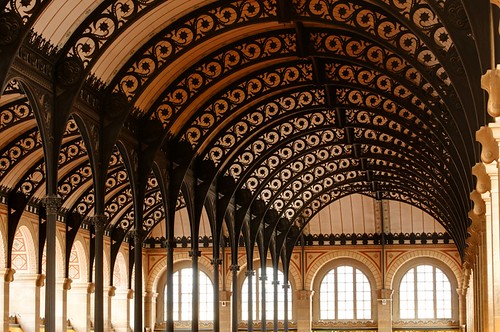1. #005 Residential
2. #006 Agricultural
3. #007 Shops, Mews & Restaurants
4. #008 Public Buildings
5. #009 Commercial Buildings
6. #010 Industrial Buildings (last week)
7. #011 Sports Buildings, Theaters & Churches (today!)
Buildings that can hold lots of people in a large, open space are a specialized type with many subtypes.
The Main Goals:
1. Have
lots of seating, all with unobstructed views of the stage/altar/podium/field/
proscenium.
2. Have
acoustics that allow the audience to hear the spoken word or music.
3. An additional very important goal is to get all those people out fast in the event of an
evacuation.
Early Theaters
The earliest gathering places I'm aware of were small,
classroom auditoriums in ancient Alexandria. The "stadium" seating was cut into the ground in a rectangular shape with the podium at the lowest rectangle, and there was likely a tent erected overhead for shade.
 |
Theater in Ostia (ancient port city near Rome)
Image courtesy of littlemisspurps via Flickr |
Then you had the
theaters of ancient Greece and Rome. These probably started out just mimicking a really great hillside, or maybe even as an alteration of a hillside into stepped seating. The early ones were usually in a semi-circular shape centered around the stage. By not having a full circle, they could make use of a natural backdrop as scenery or use props and sets. Theaters would have gotten most of their use from educational and political lectures as well as theater.
Later came
amphitheaters (same prefix as amphibian, meaning "both sides") in the full round. The
Colosseum and most of the smaller
circuses (for chariot races) were this way. So are most modern stadiums.
Same as today, they rarely had any kind of partial roof; and, if they did, it was only for the wealthy gents of status.
Synagogues & Churches
The earliest
synagogue found was in Egypt, from the third century B.C.E. Synagogues were in use by the Jewish people even during the temple periods. Those that have been unearthed have squarish-rectangular plans with a row of columns all around. They would have been used for scripture reading and communal prayer.
 |
Image in the Public Domain
Courtesy of Wikimedia Commons
Solid black areas are stone. |
Most early Christian groups met in the open air or in members' homes. For a very long time, (and for most religions) buildings for worship were temples and burial places. These were not for large groups, but individual worshippers.
After the legalization of Christianity by Constantine (fourth century A.D.), public
churches were allowed, but they were usually renovated from earlier homes & civic buildings, markedly the basilica. The
basilica was a long rectangular shape with a large central aisle and side aisles.
Basilica Maxentius (pictured on the right) is a very fine example of a civic basilica that could be used as a Christian church. One of the first things to be changed, though, was moving the entry. You can just see the fine lines that
 |
Typical Christian basilica layout. The entrance is at
the arrow. The shaded area is a Christian adaptation
called a transept. Image courtesy of
Lusitana via Wikimedia Commons |
indicate stairs at the bottom center of the image. These would have been moved so that a worshipper entering at the main stairs/doors had a very long terminating view of the altar.
Note that congregants seated in the side aisles would have a very good chance of having their view of the altar ruined by columns in the way. But the building needed those columns to help span the large open area.
Many post-Reformation churches follow a plan that harks back to the classrooms and amphitheaters of ancient time.
In a reaction against the
implied hierarchy of the basilica (us important people up here on the altar close to God, you plebeians can watch from down there in the congregation), an
emphasis on sermon rather than ordinance has changed what churches look like.
A centralized church plan may simply be a basilica with a very large transept, or a
round or square-shaped plan. This helps there be many more "good" seats and very few "nosebleed" ones.... which brings me to:
Today
 |
LDS Conference Center, Salt Lake City, built 2000
Image courtesy of pncsmith via Flickr.
I know, looks like a UFO landing, but the engineering
is much more impressive than the aesthetics. |
We still have lots of open air places to congregate for sporting events, but most other gathering spaces are indoors. This means a big fat roof to span that space, and preferably, no columns to block views.
The
Radio City Music Hall asserts that it is the largest indoor theater in the world at 6,000 seats. It opened in 1932.
In Salt Lake, we have one of the largest indoor theater-style auditoriums in the world, seating 21,000 and NO visual obstructions for any of those seats.
The
largest indoor sports arena in the world is in South Korea. The
Gwangmyeong Velodrome, completed in 2006, seats 30,000 for cycling races.
 |
Tower of Juche Idea & Rungnado May Day Stadium,
Pyongyang, North Korea
Image courtesy of yeowatzup via Flickr |
Many of the
largest outdoor sporting venues are for football (sometimes known as soccer). The Rungnado May Day Stadium in North Korea has been dominating the top of that list since 1989 with 150,000 seats. For comparison, contemporary accounts put the Colosseum's capacity at 87,000 (though modern estimates are 50,000... maybe there was a wing we don't know about).
Homework #011
Field trip in your mind:
Tell us about the best and the worst places you've been to for theater, worship or sports. Be sure to explain what was so great and what was a big fat failure (and I mean the space, not the performance!).
This Week's Q&A #011
 |
solid buttress at the Saviour Chapel, Zejtun, Malta
It looks to me like it was added later, as an afterthought
Image courtesy of Maltesedog via Wikimedia Commons |
Emma:
What is a buttress?
Ally: Buttresses are structural elements that do wonderful things for the interior and can make the exterior look like a spider.
Why so wonderful?
Situation 1. Let's say you put a nice heavy roof down on the GROUND. Its weight is distributed equally at every point where it touches the ground, and all of load is straight down. Easy peasy, the ground has no problem holding it up!
Situation 2. Same roof on two short SIDE
WALLS. Now all of that weight has to travel to the side walls: the weight that comes all the way from the center of the roof has to travel towards the side walls, too. This force pushes them out a bit.
Situation 3. Same roof on two TALL side walls. The taller they are, the more wobbly they become and the easier they are to tip over. So you decide to make them thicker and stronger with a buttress. No more topply. (
see the chapel at Malta, top right)
Situation 4. You start running out of stone for these super thick wall supports, so you start putting arches and other openings in the buttress, while still bracing the original wall. These are called flying buttresses. (
see St. Mary's, middle right) It's a lot like propping up a friend who's leaning on you.
Buttresses & flying buttresses do a great job of stabilizing tall walls with a large open space inside. If those walls also have lots of glass to let in lots of light, they need even more buttressing.
And now we have arrived at the gothic cathedral that looks like a spider on the outside.
I included the example at St. Mary's, because it's very rare that the area between the buttressing and the main enclosure walls is a place you'd want to be. At St. Mary's, it's almost a pleasant/safe area.
There are lots of nice buttress diagrams
here if my clumsy explanation was too thick.
Cheers,
ally








